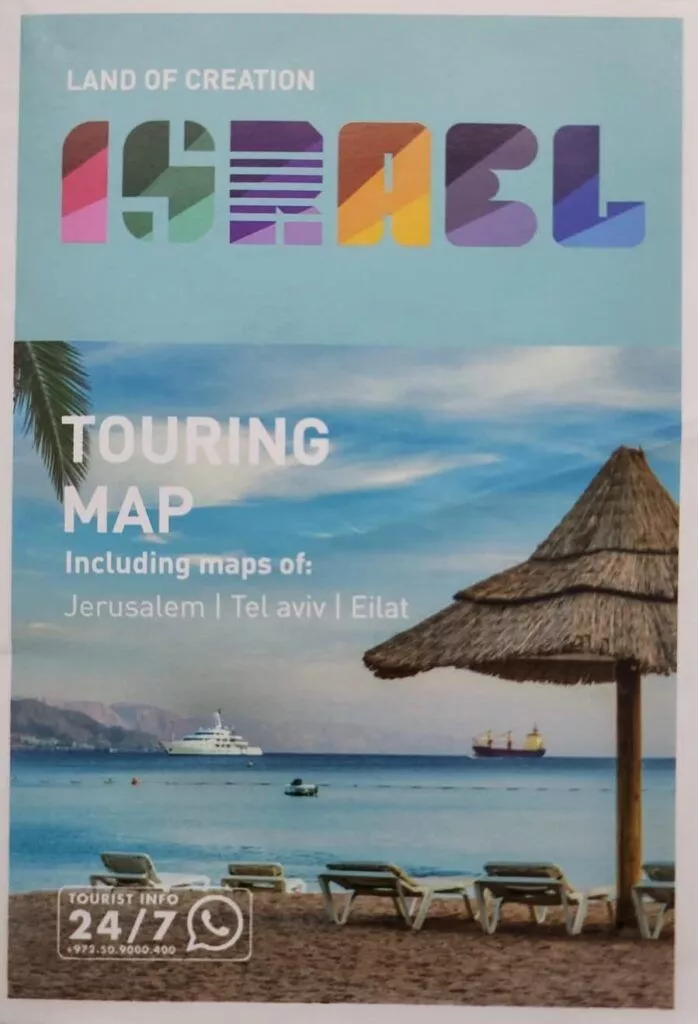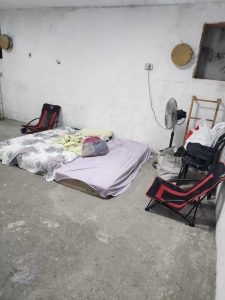Whenever I guide a group around Israel, I provide a map of Israel to each and every participant to allow them to follow our journey through the county. Not a special map, just a simple folding paper map, either one printed by the Ministry of Tourism or a map created by the agency I am working with, with their logo stamped on top. I use the same map on our journey, hanging it on the front of the bus, where it will remain for the duration of the trip. As our tour begins, I explain the outline of our country, its borders, and neighboring countries, its general topography, and geography, its road system, important regions, and cities. This serves as a starting point for our many bus rides and site explorations.
Each day I add my personal touch to the map. As we start and end the day, I point out the sites we will visit or have just visited, and the roads we will take or have just traveled. Each day I mark the sites and travel routes on the map with a different color marker. In addition, I add the date in the same color on the side of the map, right next to the map legend, hence creating our own personal itinerary. At the end of the trip, we have a map that is significant to our specific journey. There, right in front of them, is a colorful piece of ‘art’ that represents all that we have accomplished, all the places we have visited, and all the travel we have done. Someone always asks to take it, and I hand it over for them to take home as a souvenir. I have received over the years pictures of this map hanging on the walls of homes far away from the land of Israel.
Among the things I always point out on the map, this regular tourist map of the country is what is shown beyond the borders. Or should I say the lack of anything beyond our borders? This phenomenon always strikes me when I travel abroad and purchase a map of the country I am traveling to. For example, a couple of years back I traveled with my family throughout Italy. We flew into Geneva Switzerland, rented a car, and drove through France to arrive at the Italian Alps, where we spent a week in the wonderful little town of Sestriere. From there we drove to Tuscany for a couple of days, followed by a week in the picturesque city of Assisi in the Umbria region, the heart of Italy. At last, we traveled to Rome to catch our flight home. Over the three weeks, we did quite a lot of traveling and in addition to following GPS, I followed the map of Italy I purchased in Israel before we departed. Every time I took a look at the map, I needed to focus my attention in order to find the borders of Italy. The borders are marked on the map, yet the map itself, its details, and description of the topography, road systems, cities, and towns, continue regardless of the borders and the surrounding countries. The map ends at the end of the paper it is printed on.
This is not the case when we talk about our map of Israel, remember the regular one that I hand out to every client. Beyond the borders of Israel lies large areas of solid color paper. The name of the neighboring countries is usually spread out over the area, and in some cases, a city or two may appear as a dot in the middle of the desert. Even rarer is to find any representation of a road system in these countries. I am not referring to roads that begin in Israel and continue beyond the border, though these also are not found. I mean any roads in our neighboring countries. If one were to open the map to its full length, hang it on the wall, and take a step back, he or she could come to the conclusion that the state of Israel is a standalone state surrounded by sea and desert.
What do we have on these large portions of empty paper? It is like an empty canvas used in many ways: Company logos, tourist attraction promotion and advertisement, a table of Israeli cities and road distances, pictures of major cities, railroad lines and stations – almost anything you can think of regarding the State of Israel.
Once you look at the map of the border of the State of Israel it is almost like a regular map. Yet, also within the border of Israel, we have empty areas. Most paper maps of Israel today do the same for the Gaza Strip. Granted, The State of Israel has had no citizens living within the Gaza Strip since 2005. Current maps, in many cases, treat the Gaza Strip exactly like our neighboring countries. In many cases, the color filling the Gaza strip is not sold but rather striped or crisscrossed, alluding that this is slightly different. Once again, I don’t want to overgeneralize, but there are maps that have a representation of the major north-south road that runs through the center of the strip, and three of its major cities (Gaza, Khan Yunis, and Rafi’ah) and maybe even a border crossing or two (Erez, Qarni, Kerem Shalom). Nevertheless, it is clear we are looking at something else, something not humongous, not holistic to the State of Israel.
The center of the map brings us to another issue of representation within the borders of the state of Israel between the Mediterranean Sea on the west and the Jordan River to the East. There are many names for this area: West Bank, Judea, and Samaria, the occupied territories, the disputed territories, just the territories, and Palestine. Depending only on the term I use, many will automatically determine my political affiliation. That said, when you have a conversation with someone their vocabulary could be an indication of political views, or could just be a cultural habit, the term used in their social and media circles. The language of maps is very different. Remember we are discussing visual representation on the map. Lines, colors, and language on a map have been chosen and determined by the sponsor and publisher. The name of the area has a meaning. The existence of, or lack of, representation of the separation between sovereign Israel and these territories has meaning. Representation, or lack thereof, of cities, villages, and ‘settlements’ in addition to the names that are used to recognize these areas have meaning. For example, the name of the city Jerusalem or El Quds, Shechem or Nablus, representation of Ramallah, El Bira, Betuniya or Pesagot, and Bet El. Some maps have shades of colors representing the status of the territory according to the Oslo Accords, and some don’t. When taking a map in our hands we must ask the question, who does this map represent? When one is dealing with this area, I suggest having multiple maps in order to compare agendas, or at the very least remind us that the map we are using has an agenda that we should be aware of.
What makes the discovery of the emptiness-representation of our neighboring countries so intriguing is the fact that Israel is so small and many visitors and tourists have the opportunity to come close to one if not all of its borders over the course of one trip. In many cases overlooking the border is planned and appears on their itinerary, whether it is part of learning about the Israeli battles and wars or getting an in-the-field briefing on the geopolitical situation of the region. Some may even be observing the current events across the border- a glimpse most western people can’t easily gain from within those countries. Today, along the entire length of the borders of the State of Israel we have a physical security barrier. It is made up of many layers of defense, including cameras and watchtowers for detection, fences, and other obstacles that prevent penetration and illegal crossing of the border. It is safe along our borders, and therefore easy to come close to. Many main roads run along the borders; farmers farm the fields all the way up to the border making sure to utilize every possible piece of land.
So, whenever we overlook the border no matter where it is: in the Galilee overlooking Lebanon, on a hill in the Golan Heights overlooking Syria, along the Jordan Valley or the Arava valley overlooking the Kingdom of Jordan, at the gulf of Eilat looking into the Egyptian Sinai Desert, the Jordanian city of Aqaba and a strip of the Saudi Arabian coast all at once, in the western Negev looking into the Gaza Strip, or anywhere in the center of Israel along the Israeli Palestinian security barrier, one thing is clear – beyond our border is not empty.
What we see on the other side of our borders is not important to me at this point. Detailed description, comparison, or analysis of what we see at the borders should be done and is done at the overlooks. So, as our conversation is regarding our maps, I will limit my explanation to stating that there are roads, people, villages, towns and cities, farming, and agriculture all on the other side. Yet our map is empty.
However, one thing that does strike us at the borders is the physical barrier and many army posts along the border. When I was in Italy, these were nowhere to be seen. While we were at Sestriere for the week, 11 km from the French border, there was no problem driving back and forth, and so we did. Fortunately for us, our map continued into France and did not stop. When you stand at an Israeli border, however, it is clear there is nowhere to go. Even at the borders of countries that have a peace agreement with Israel, like Egypt and the Kingdom of Jordan, you can’t just drive across. The borders are sealed and crossing is done only at a few border crossings.
Standing at an Israeli border you come to the realization that here is us, the State of Israel, and there is them. Some would say, there is Israel, and on the other side is the enemy. The population we see on the other side, or even the individuals don’t matter, their country is the enemy and out of our limits. At the end of the day, you understand that once you reach the border there is nowhere else to go.
This is also how we and our leaders often portray ourselves to the world. In many cases, political, ideological, religious, and other rhetoric presents Israel as an island. An Island of democracy with western values and orientation, an island of stability with great military power and economic success on a global scale, an island of holiness deeply rooted in the origins of religion and culture, and a place of religious yearning and hope for the future. Once again, there is us and them, and they are the ocean we are in the middle of and there is nowhere to go. Just like our map, we are surrounded. But what surrounds us is nothing, just emptiness.
It is possible that this is what underlines the perception of the producers of our maps- the sponsors, cartographers, and creators. These maps present a notion that what lies beyond the borders of the State of Israel is not relevant. Because the reality is that it isn’t relevant. You can’t drive there or even cross for a short visit. And so, when I show this blank space beyond our borders on each of my tours, I share these thoughts, these considerations. But I also can’t help wondering if rather than being a deliberate attempt to make a point, it has simply become a pre-existing design, being used again and again by printers and sponsors following these pre-existing patterns.




